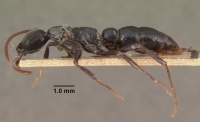Leptogenys voeltzkowi
| Leptogenys voeltzkowi | |
|---|---|

| |
| Scientific classification | |
| Kingdom: | Animalia |
| Phylum: | Arthropoda |
| Class: | Insecta |
| Order: | Hymenoptera |
| Family: | Formicidae |
| Subfamily: | Ponerinae |
| Tribe: | Ponerini |
| Genus: | Leptogenys |
| Species group: | incisa |
| Species complex: | voeltzkowi |
| Species: | L. voeltzkowi |
| Binomial name | |
| Leptogenys voeltzkowi Forel, 1897 | |
The pattern of distribution for L. voeltzkowi shows that it occupies the dry, transitional humid, lowland, and littoral forests in the north and northeast of Madagascar. It forages in leaf litter and nests mainly in rotten wood and under rocks.
Identification
A member of the voeltzkowi complex of the incisa species group. Rakotonirina and Fisher (2014) - Worker. Median portion of clypeus projecting anteriorly into short, narrowly rounded lobe; anteriorly projecting peg-like setae present from near anterior margin of median lobe of clypeus, above semi-translucent lamella; antennal scape relatively short (SI: 101–114), less than one fourth its length surpassing posterior margin of head; in full-face view, eye not breaking line of cephalic lateral border; in profile, posterior margin of petiolar node with constriction at posteroventral angle, near junction to gaster; dorsum of body without erect hairs longer than maximum diameter of eye.
This species can be separated from the remainder of the group by the following combination of characters: the very short standing hairs, which may be absent, on dorsum of the body, and the eyes usually not breaking the line of the cephalic lateral margin. Specimens from the forest of Binara near Daraina have a head that is narrower posteriorly, eyes that break the outline of the sides of the head, and mandibles that increase in width from the basal third to near the apical teeth. Workers from RS Manongarivo and RS Marotandrano have a weak convexity at the mid-length of their mandible, and the width of the blades decreases towards the apical portion. Mandibular blades of specimens from both localities are longitudinally striate.
Keys including this Species
Distribution
Distribution based on Regional Taxon Lists
Malagasy Region: Madagascar (type locality).
Distribution based on AntMaps
Distribution based on AntWeb specimens
Check data from AntWeb
Countries Occupied
| Number of countries occupied by this species based on AntWiki Regional Taxon Lists. In general, fewer countries occupied indicates a narrower range, while more countries indicates a more widespread species. |

|
Estimated Abundance
| Relative abundance based on number of AntMaps records per species (this species within the purple bar). Fewer records (to the left) indicates a less abundant/encountered species while more records (to the right) indicates more abundant/encountered species. |

|
Biology
|
Castes
Images from AntWeb
 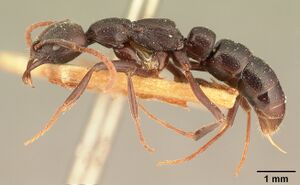 
| |
| Lectotype of Leptogenys voeltzkowi. Worker. Specimen code casent0101888. Photographer April Nobile, uploaded by California Academy of Sciences. | Owned by MHNG, Geneva, Switzerland. |
   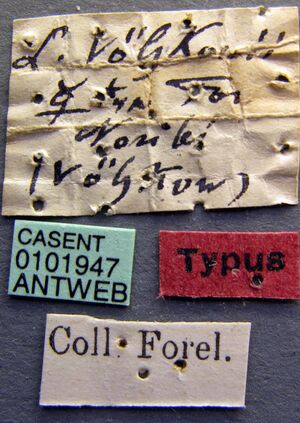
| |
| Paralectotype of Leptogenys voeltzkowi. Worker. Specimen code casent0101947. Photographer April Nobile, uploaded by California Academy of Sciences. | Owned by MHNG, Geneva, Switzerland. |
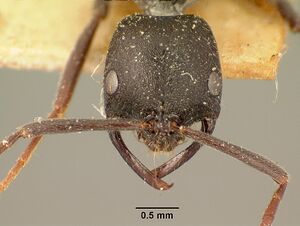 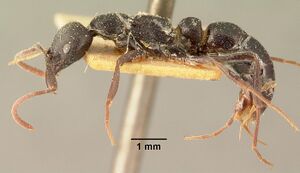  
| |
| Paralectotype of Leptogenys voeltzkowi. Worker. Specimen code casent0101989. Photographer April Nobile, uploaded by California Academy of Sciences. | Owned by MHNG, Geneva, Switzerland. |
    
| |
| Type of Leptogenys voeltzkowi. Worker. Specimen code casent0104564. Photographer April Nobile, uploaded by California Academy of Sciences. | Owned by ZMHB, Berlin, Germany. |
 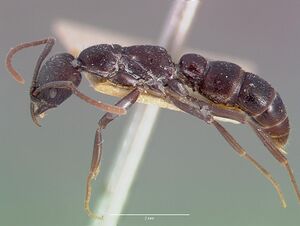  
| |
| Worker. Specimen code mcztype20493. Photographer April Nobile, uploaded by California Academy of Sciences. | Owned by MCZ, Cambridge, MA, USA. |
Nomenclature
The following information is derived from Barry Bolton's Online Catalogue of the Ants of the World.
- voeltzkowi. Leptogenys voeltzkowi Forel, 1897c: 194 (w.) MADAGASCAR.
Unless otherwise noted the text for the remainder of this section is reported from the publication that includes the original description.
Description
SHOULD BE Worker
Worker
Rakotonirina and Fisher (2014) - (9 specimens). HW: 1.30–1.59, HL: 1.39–1.72, CI: 90–95, SL: 1.31–1.60, SI: 101–114, PW: 0.90–1.15, WL: 2.26–2.72, PNH: 0.77–0.92, PNL: 0.62–0.71, PNW: 0.71–0.84, DNI: 113–125, LNI: 123–134.
Head weakly broader at front than behind; sides feebly convex and diverging anteriorly; posterior margin very weakly concave. Eye large, slightly protruding from surface of head, and not breaking outline of side of head. Antennal scape relatively short (SI: 101–114). Clypeus with convex lateral margin, which strongly tapers into narrowly rounded anteromedian lobe; thin, rounded subopaque lamella surrounding anteromedial clypeal lobe. Mandible elongate and slender, feebly angulate near base and not fully closed against clypeus, leaving gap when at rest; basal groove narrowly impressed. In dorsal view, mesosoma with impressed metanotal groove; in profile, mesosoma somewhat high and short, with broadly convex dorsal margin; propodeal lobe absent. Posterior face of petiolar node impressed or with groove at about posteroventral portion, near junction to gaster; in profile, node about as high as broad, anterior face meeting in convex line with dorsal margin, forming distinct angle with posterior face. Constriction between third and fourth abdominal segments weakly noticeable. Mandible generally smooth between sparse punctures, with piligerous pits; head dorsum densely reticulate-rugulose, interspersed with small punctures. Dorsum of mesosoma, node of petiole and abdominal tergites III and IV generally punctate, with fine microreticulation. Sides of mesosoma rugulose at the suture between mesopleuron and metapleuron. Standing hairs and pubescence present on dorsum of head, but very short or absent on other parts of body dorsum. Black species, appendages dark brown with lighter apical portion; tip of gaster brown.
Type Material
Rakotonirina and Fisher (2014) - Lectotype worker, present designation, Madagascar, Antsiranana, Nosy-be (Voeltzkow), AntWeb specimen code CASENT0101888 (Musee d'Histoire Naturelle Genève). Paralectotypes: two workers with same data but with the following specimen codes: CASENT0101947, CASENT0101989 (MHNG) [examined].
References
- Bolton, B. 1975a. A revision of the ant genus Leptogenys Roger (Hymenoptera: Formicidae) in the Ethiopian region with a review of the Malagasy species. Bull. Br. Mus. (Nat. Hist.) Entomol. 31: 235-305 (page 234, see also)
- Forel, A. 1897d. Ameisen aus Nossi-Bé, Majunga, Juan de Nova (Madagaskar), den Aldabra-Inseln und Sansibar, gesammelt von Herrn Dr. A. Voeltzkow aus Berlin. Mit einem Anhang über die von Herrn Privatdocenten Dr. A. Brauer in Marburg auf den Seychellen und von Herrn. Abh. Senckenb. Naturforsch. Ges. 21: 185-208 (page 194, worker described)
- Rakotonirina, J.C. & Fisher, B.L. 2014. Revision of the Malagasy ponerine ants of the genus Leptogenys Roger (Hymenoptera: Formicidae). Zootaxa 3836, 1-163.
References based on Global Ant Biodiversity Informatics
- Bolton B. 1975. A revision of the ant genus Leptogenys Roger (Hymenoptera: Formicidae) in the Ethiopian region with a review of the Malagasy species. Bulletin of the British Museum (Natural History). Entomology 31: 235-305.
- Emery C. 1911. Hymenoptera. Fam. Formicidae. Subfam. Ponerinae. Genera Insectorum 118: 1-125.
- Fisher B. L. 1997. Biogeography and ecology of the ant fauna of Madagascar (Hymenoptera: Formicidae). Journal of Natural History 31: 269-302.
- Fisher B. L. 2003. Formicidae, ants. Pp. 811-819 in: Goodman, S. M.; Benstead, J. P. (eds.) 2003. The natural history of Madagascar. Chicago: University of Chicago Press, xxi + 1709 pp.
- Forel A. 1897. Ameisen aus Nossi-Bé, Majunga, Juan de Nova (Madagaskar), den Aldabra-Inseln und Sansibar, gesammelt von Herrn Dr. A. Voeltzkow aus Berlin. Mit einem Anhang über die von Herrn Privatdocenten Dr. A. Brauer in Marburg auf den Seychellen und von Herrn Perrot auf Ste. Marie (Madagaskar) gesammelten Ameisen. Abhandlungen der Senckenbergischen Naturforschenden Gesellschaft 21: 185-208.
- Rakotonirina J. C., and B. L. Fisher. 2014. Revision of the Malagasy ponerine ants of the genus Leptogenys Roger (Hymenoptera: Formicidae). Zootaxa 3836 (1): 001163.
- Wheeler W. M. 1922. Ants of the American Museum Congo expedition. A contribution to the myrmecology of Africa. IX. A synonymic list of the ants of the Malagasy region. Bulletin of the American Museum of Natural History 45: 1005-1055
